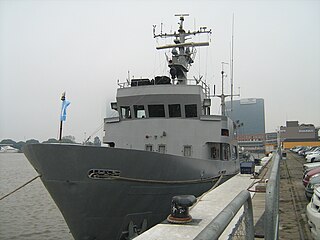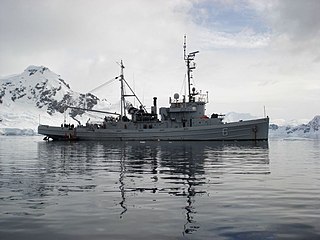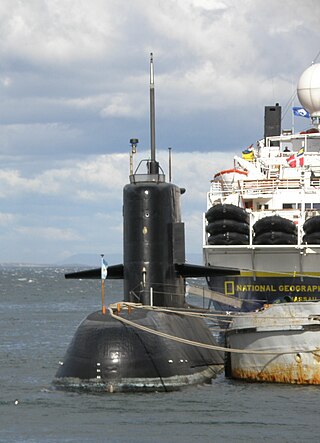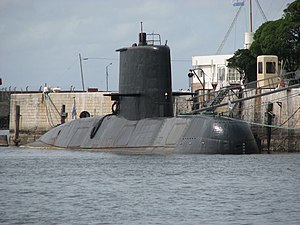
The Argentine Navy is the navy of Argentina. It is one of the three branches of the Armed Forces of the Argentine Republic, together with the Army and the Air Force.

ARA Almirante Irízar is a large icebreaker of the Argentine Navy. She was ordered from a shipyard in Finland in 1975.

ARA Patagonia (B-1) is a multi-product replenishment oiler of the Durance class in service in the Argentine Navy. She was the lead ship of her class serving in the French Navy as Durance from 1977 to 1999. In French service, the ship served with the Force d'action navale. In Argentine service the vessel is used in multi-national naval exercises and supplies the Antarctic missions operating from Ushuaia. In 2017, Patagonia was used to search for the missing submarine ARA San Juan.

INVAP S.E. is an Argentine company that provides design, integration, construction and delivery of equipment, plants and devices. The company operates in North America, Europe, Asia Pacific, Latin America, the Middle East and Africa, and delivers projects for nuclear, aerospace, chemical, medical, petroleum and governmental sectors.

The Drummond class are three corvettes designed and built in France based on the A69 D'Estienne d'Orves-class avisos. The ships were commissioned in the Argentine Navy between 1978 and 1982.

The TR-1700 is a class of diesel-electric patrol submarines built by Thyssen Nordseewerke for the Argentine Navy in the 1980s, with two submarines completed. These ships are amongst the largest submarines built in Germany since World War II and are among the fastest diesel-electric submarines in the world. ARA San Juan was lost on 17 November 2017, leaving ARA Santa Cruz as the only remaining submarine of this class. As of 2020, the refit of Santa Cruz has been reported cancelled leaving the entire class inactive.

ARA Comodoro Rivadavia (Q-11) is a survey ship of the Argentine Navy assigned to the national Hydrographic Naval Service which among other things is responsible of the maintenance of nautical charts and navigational aids

ARA Suboficial Castillo (A-6) was an Abnaki-class tug/patrol boat of the Argentine Navy. She previously served in the United States Navy as USS Takelma (ATF-113) from 1944 to 1992. The ship was acquired by Argentina in 1993 and was in service until the 2020s. In 2022, the ship was put up for sale. Suboficial Castillo was used as support ship for both the Argentine Submarine Force and during the summer campaigns in Antarctica in the Patrulla Antártica Naval Combinada with the Chilean Navy to guarantee safety to all touristic and scientific ships that are in transit within the Antarctic Peninsula.

ARA Granville (P-33) is a Drummond-class corvette of the Argentine Navy named after Guillermo Enrique Granville, who fought in the 1827 Battle of Juncal against Brazil.

ARA Santa Cruz (S-41) is a member of the TR-1700 class of diesel-electric submarines of the Argentine Navy.

ARA Salta (S-31) is a Type 209 diesel-electric attack submarine in service with the Argentine Navy. The vessel was reported as incapable of navigation as of 2020. However, Argentine navy divers were reported to be using her as a training platform at dockside.

ROU 26 Vanguardia is a Piast class salvage and marine research vessel in service with the Uruguayan Navy. The ship was laid down for the East German Navy in 1976, before being acquired by the German government after the Reunification of Germany. The ship was purchased by the Republic of Uruguay in 1991 and renamed Vanguardia.
On 15 November 2017, the Argentine submarine ARA San Juan disappeared off the coast of Argentina while on a training exercise. After a search lasting 15 days, the Argentine Navy downgraded the operation from a rescue mission to a search for the submarine's wreck, implying they had given up any hope of finding survivors among its crew of 44. It was the worst submarine disaster since the accident on Chinese submarine 361 in 2003, and the second worst peacetime naval disaster in Argentina after the 1949 sinking of the minesweeper ARA Fournier.

Eliana María Krawczyk was an officer of the Argentine Navy. She was among the 44 crew members of the Argentine submarine ARA San Juan when it sank on 15 November 2017.

Rafael Mariano Grossi is an Argentine diplomat. He is serving as Director General of the International Atomic Energy Agency (IAEA) since December 3, 2019. He was formerly the Argentine Ambassador to Austria, concurrent with Slovenia, Slovakia and International Organisations based in Vienna (2013–2019).
Coming Home is a 2018 Argentine film directed and written by Ricardo Preve. Defined by Preve as a docufiction production, Coming Home is based on the story of Carlo Acefalo, an Italian sailor who died in a desert island during World War II and whose remains were repatriated to his native country in 2018. The film had a successful run at international festivals, winning awards and nominations.
The spying on the family members of the sailors of the ARA San Juan was a series of events happened in Argentina that consisted in the illegal spying and monitoring of people who were relatives of the crew members who died due to the sinking of the Argentine Navy submarine on November 15, 2017, carried out by agents of the Federal Intelligence Agency (AFI). The facts have been considered a priori as a crime by the Argentine justice system, which proceeded to open the investigation under the direction of Judge Martín Bava of the city of Dolores, Argentina. High-ranking Argentine State authorities have been charged in the case, among them the then President Mauricio Macri, the former heads of the AFI Gustavo Arribas and Silvia Majdalani and the former head of the Mar del Plata Naval Base, from which the sunken submarine was based.















